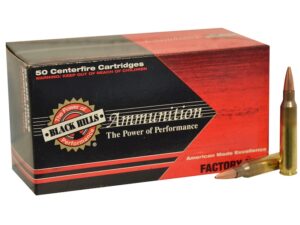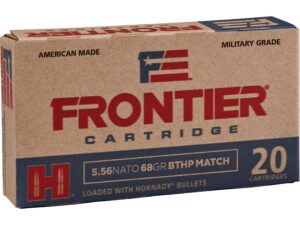5.56 Ammo for Sale
-
5.56 Ammo for Sale
500 Rounds of Black Hills Ammunition 5.56x45mm NATO 69 Grain Sierra MatchKing Hollow Point Box of 50 For Sale
Original price was: $800.00.$640.00Current price is: $640.00. Add to cart -
5.56 Ammo for Sale
500 Rounds of Black Hills Ammunition 5.56x45mm NATO 69 Grain Sierra Tipped MatchKing (TMK) Box of 50 For Sale
Original price was: $900.00.$720.00Current price is: $720.00. Add to cart -
5.56 Ammo for Sale
500 Rounds of Black Hills Ammunition 5.56x45mm NATO 70 Grain Hornady GMX Hollow Point Boat Tail Lead-Free Box of 50 For Sale
Original price was: $1,100.00.$880.00Current price is: $880.00. Add to cart -
5.56 Ammo for Sale
500 Rounds of Black Hills Ammunition 5.56x45mm NATO 77 Grain Sierra MatchKing Hollow Point For Sale
Original price was: $820.00.$656.00Current price is: $656.00. Add to cart -
5.56 Ammo for Sale
500 Rounds of Black Hills Ammunition 5.56x45mm NATO 77 Grain Sierra Tipped MatchKing (TMK) Box of 50 For Sale
Original price was: $900.00.$720.00Current price is: $720.00. Add to cart
Looking for 5.56 ammo for sale? Look no further than FirearmsSite.com! We carry a wide range of 5.56×45 ammo from top brands like Aguila and Barnes, so you’re sure to find the perfect round for your needs. Our selection of bulk 5.56 ammo is unbeatable, and we offer free shipping on all orders over $500! Whether you’re looking to stock up on ammunition or complete your training, we have the right rounds for you. Order now and experience the best in customer service!
Bulk 5.56×45 Ammo in Stock
If you’re looking for bulk 5.56 ammo, then you’ve come to the right place! At Firearms Site we carry only the highest quality 5.56×45 Ammo that you can count on when you need it most. We offer a variety of sizes and options in our 5.56 ammo for sale so regardless of what rifle you have, you’ll be able to find what you need. Our bulk 5.56 ammo is some of the best on the market and we take great pride in offering a product that shooters can rely on time and time again. With our selection of 5.56 caliber ammunition, you’ll always be sure to get great value for your money and savor the experience of every shot. So don’t delay, order your 5.56 bulk ammo 2000 rounds today! Our fast shipping will get it to you in no time. Shop with confidence at Firearms Site!
Buy 5.56 Ammo Online – Firearmssite.com
5.56 Ammo (official NATO nomenclature nomenclature; 5.56 NATO) is a rimless bottlenecked intermediate cartridge developed during the late 1970s in Belgium by FN Herstal. It comprises three cartridges: SS109, L110, and SS111 cartridges. On the 28th of October, 1980, under STANAG 4172, it was made the second standard cartridge for service rifles used by NATO forces and for many non-NATO nations. Although they’re not wholly identical, they are similar in their design. 5.56 Ammo cartridge family was developed from and is identical to the .223 Remington cartridge designed by Remington Arms in the 1960s.
5.56 Ammo Cartridge Dimension
The 5.56 Ammo has 1.85 ml (28.5 grains H2O) cartridge case capacity.

5.56 NATO cartridge dimensions. All sizes in millimeters (mm)
The twist rate of the rifling for 5.56 Ammo is 177.8 mm (1 in 7 inches). Six grooves left-hand twist O land equals 5.56 millimeters (0.219 in). O grooves equal 5.69 millimeters (0.224 in).
By STANAG 4172, as well as official NATO guidelines for proofing, the 5.56 NATO case can handle up to 420.0 MPa (60,916 psi) piezo pressure. In NATO-authorized organizations, each rifle cartridge must be tested to 537.5 MPa (77,958 psi) to be certified for service issues. STANAG 4172 stipulates the Belgian ball cartridge SS109 as the NATO reference cartridge.
It also includes many technical requirements, including the need for a minimum pressure requirement that is 88.0 MPa (12,763 psi) at the gas port, 280 millimeters (11.0 in) down to the 508 millimeters (20.0 in) long standard proof barrel, and sensitivity, which are not specified by the civilian C.I.P. and SAAMI ammunition regulations and guidelines.
NATO military alliance employs an approved set of procedures for ensuring the quality and safety of ammunition used in firearms, known as NATO EVAT tests. The civil organizations C.I.P. and SAAMI use less extensive test methods than NATO.
NATO Manual of Proof and Inspection A.C./225 (LG/3-SG/1) D/8 states that every weapon and the part that is deemed to be susceptible to the consequences of a rapid shift in pressure, such as for instance, barrels, breech blocks, bolts, is examined by firing one dry round with the correct minimum of 25% above pressure, and one oiled game with an accuracy of at least 25 percent overpressure.
Overpressure of 25% is 25% over the service pressure, resulting in a 5.56 Ammo up to 430.0 MPa (62,366 psi) (Pmax) piezo service pressure. The term “service pressure” is defined as the average pressure produced using the service cartridge temperatures of 21 degrees Celsius (70 degrees Fahrenheit). This high-pressure test is carried out using the ammunition and weapon adjusted at an atmosphere temperature of 21°C (70 degrees Fahrenheit).
Each gun is individually checked, operating an ammunition source with the minimum correct mean chamber pressure. The formal proof pressure requirement (service pressure (Pmax) plus 25 percent) for 5.56 Ammo, like the STANAG 4172, is 537.3 MPa (77,929 psi) (P.E.) piezo pressure. The pressure is recorded in a NATO-designed EPVAT barrel fitted with Kistler transducer 6215 HPI GP6 Transducer and using equipment that meets C.I.P. requirements.
The US SAAMI provides the max average pressure (M.A.P.) for the .223 Remington cartridge as 55,000 psi (379.2 MPa) piezo pressure that has a possibility of a deviation up to 58,000 PSI (399.9 MPa).
5.56 Nato Rifle Barrel Configuration
In the year 1980 that 5.56 Ammo was adopted as the standard, NATO chosed a 178 millimeter (1:7) twist rate for the rifling in this 5.56 Ammo chambering to adequately ensure the stability of the lengthy NATO M856/L110 5.56 NATO tracer projectile. The US then transformed all the rifles in stock by replacing the barrels, and every newly developed US military rifle has since been made using this ratio.
In the US, makers of AR-type rifles can specify barrels that have either .223 Remington, .223 Wylde, 223 Noveske, or 5.56 Ammo chambers in lengths that range from the pistol (7.5″) to long rifle (24″). They are also available with riflings ranging from 356 millimeters (1-in-14″) to 178 mm (1-in-7″).
US manufacturers are moving towards 5.56 Ammo and 178 mm (1-in-7″), the most risk-free option. A bolt-action rifle offers several options. They that are chambered for .223 Remington may not have an adequate rifling speed to ensure stability for the larger 5.56 Ammo bullets, which range from 77 grams to 77 grams. Specific hunting loads made of .223 Remington go to 90 grains.
5.56 Ammo Performance
5.56 Ammo SS109/M855 cartridge (NATO: SS109; U.S. M855) comes with a standard 62 gr. Lead core bullets with a steel penetrator can penetrate around 38-51 cm (15 to 20 inches) in soft tissues under ideal conditions. Like all spitzer-shaped projectiles, they are prone to yaw in soft tissues. However, when the impact velocity is over 762 millimeters per second (2,500 feet/s), it could slide and then split in the cannelure (the groove for crimping around the cylindrical cylinder of the bullet). The fragments may disperse into bone and flesh, causing additional internal injuries.
Fragmentation can cause more damage to human tissues when and if it happens than the bullet’s dimensions and velocity could suggest. The fragmentation effect depends on speed and, consequently, the length of the barrel: shorter-barreled carbines produce lesser muzzle velocity and reduce wounding power at shorter distances than rifles with longer barrels.
Proponents of the hydrostatic-shock theory claim that the shockwave generated by high-velocity ammunition causes injuries that extend beyond the tissue that is directly crushed and torn by the bullet and fragments. Others claim that the damage to tissue caused by hydrostatic shock is an untruth. Many critics argue that ultrasound waves do not cause tissue disruption and that the formation of a temporary cavity is the real reason behind tissue disintegration resulting from sonic pressure waves.
The SS109/M855 NATO ball can pierce up to 3 millimeters (0.12 inches) from steel in 600 meters. Based on Nammo, the Finnish-Norwegian ammunition maker, The 5.56 NATO M995 armor-piercing cartridge can penetrate as much as 12 millimeters (0.47 inches) in RHA steel up to 100 meters.
The U.S. Army’s Ballistic Research Laboratory measured a ballistic coefficient (G7 BC) of 0.151 and a form factor (G7 I) in the range of 1.172 for the ball projectile SS109/M855.
It is believed that the Swedish Military has measured the velocity of the bullets fired by SS109/M855 cartridges at 4 meters (13.1 feet) in the muzzle that fired with different barrel lengths.
| Barrel length | SS109/M855 V4 bullet velocity | V4 velocity loss |
|---|---|---|
| 210 mm (8.3 in) | 723 m/s (2,372 ft/s) | 41 m/s (135 ft/s) |
| 240 mm (9.4 in) | 764 m/s (2,507 ft/s) | 32 m/s (105 ft/s) |
| 270 mm (10.6 in) | 796 m/s (2,612 ft/s) | 29 m/s (95 ft/s) |
| 300 mm (11.8 in) | 825 m/s (2,707 ft/s) | 18 m/s (59 ft/s) |
| 330 mm (13.0 in) | 843 m/s (2,766 ft/s) | 23 m/s (75 ft/s) |
| 360 mm (14.2 in) | 866 m/s (2,841 ft/s) | 12 m/s (39 ft/s) |
| 390 mm (15.4 in) | 878 m/s (2,881 ft/s) | 14 m/s (46 ft/s) |
| 420 mm (16.5 in) | 892 m/s (2,927 ft/s) | 14 m/s (46 ft/s) |
| 450 mm (17.7 in) | 906 m/s (2,972 ft/s) | 9 m/s (30 ft/s) |
| 480 mm (18.9 in) | 915 m/s (3,002 ft/s) | 7 m/s (23 ft/s) |
| 508 mm (20.0 in) | 922 m/s (3,025 ft/s) | – |
5.56 Ammo vs 7.62mm NATO
| Cartridge | Model | Cartridge size | Cartridge weight | Bullet weight | Velocity | Energy |
|---|---|---|---|---|---|---|
| 5.56mm NATO | M855 5.56mm (5.56 × 45 mm) Ammunition | 5.56×45mm | 12.31 g (190 gr) | 4.02 g (62 gr) | 922 m/s (3,025 ft/s) | 1,709 J |
| 7.62mm NATO | M80 7.62mm (7.62 × 51 mm) Ammunition | 7.62×51mm | 25.40 g (392 gr) | 9.33 g (144 gr) | 838 m/s (2,749 ft/s) | 3,275 J |
Hit probability is the capacity of soldiers to remain focused on firing despite the recoil of their weapon and its noise which differs between cartridges. The 7.62 NATO has twice the impact power of the 5.56 NATO Ammo, preferable when a target is secured by higher-level armor and is particularly effective in the “medium” range.
If otherwise, both rounds can effectively penetrate enemy targets up to 600 meters, or approximately. 5.56 Ammo rounds fired from 20-inch (510 millimeters) barrel can follow a flatter trajectory than the 7.62 NATO round fired from the same barrel, and it is the 5.56 NATO fired from a 14.5 in (370 millimeters) barrel follows the same trajectory similar to those fired with the 7.62 NATO from a 20 in barrel, and the same speed of flight. 7.62 NATO rounds can travel at the same speed. 7.62 NATO round reaches 50 percent of its velocity within 80 millimeters (3.1 inches) from the barrel at the time of firing, and reducing the barrel’s length to combat close quarters can result in increased muzzle force and a more excellent muzzle flash.























